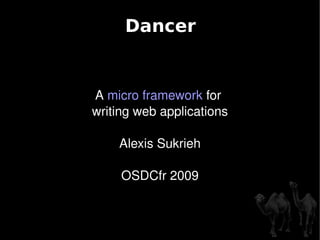
Writing webapps with Perl Dancer
- 1. Dancer A micro framework for writing web applications Alexis Sukrieh OSDCfr 2009
- 2. Alexis Sukrieh http://sukria.net http://twitter.com/sukria http://search.cpan.org/~sukria/
- 3. Dancer http://dancer.sukria.net $ sudo cpan Dancer http://github.com/sukria/Dancer
- 4. Description Syntax Application Tree Environments Deployment
- 5. webapp framework for Perl
- 6. Again, another one !!?
- 7. YES.
- 8. Why ?
- 9. Web Development in Perl can be :
- 10. CGI.pm : fat webapp junkfood
- 11. Catalyst : it's huge, but, it's huge.
- 12. Plenty of other frameworks alike
- 13. Ruby introduced something else
- 14. A new approach to webapp development
- 15. Perl needed the same
- 16. definetly
- 17. Kindly stolen from Ruby
- 18. So, Dancer is a framework ...
- 19. a micro framework
- 29. package MyApp ; use Dancer; get '/' => sub { 'Hello OSDCfr 2009!' }; dance;
- 30. A dancer script is a webserver
- 31. $ ./myApp.pl >> Listening on 127.0.0.1:3000 == Entering the development dance floor ...
- 32. Working webapp ready to be hacked
- 33. » happiness : he can WSFC now
- 34. Description Syntax Application Tree Environments Deployment
- 35. A Dancer app is defined with route handlers
- 36. a route handler is basically a sub
- 37. bound to an HTTP method (typically ' get ' or ' post ')
- 38. with a path pattern
- 39. /foo /bar/:var /baz/* r('/stuff/([a-z0-9]+)/')
- 40. Static pattern (path) / /foo /bar/baz
- 41. pattern with named tokens /hello/:buddy my $name = params->{buddy}
- 42. pattern with anonymous tokens /show/*.* my ($file, $ext) = splat;
- 43. pseudo-regexp-defined patterns r('/post/([a-z0-9]+)') my ($post) = splat; # $1
- 44. processing a request = finding a matching route handler
- 45. 404 No matching route handler » no joy
- 46. Route handler found » Joy
- 47. When found, a route handler is executed
- 48. it can alter the response headers get '/' => sub { content_type 'text/plain'; return 'this is plain text' };
- 49. pass to the next matching handler get '/lazy' => sub { pass and return false; };
- 50. serve a static file get '/dowload/:file' => sub { my $file = params->{file}; if (! -f $file) { pass and return false; } send_file $file; };
- 51. throw an error get '/forbidden' => sub { send_error 'Nope'; };
- 52. redirect to somewhere else get '/forbidden' => sub { redirect '/better/place' };
- 53. and of course, render a content get '/showme' => sub { template 'showme', { var => 'foo'}; };
- 54. return value = content to render
- 55. logging ?
- 56. get '/' => sub { # ... debug 'here it is'; }; » logs/development.log
- 57. pre-processing ?
- 58. before sub { do_some_init_stuff(); params->{foo} = 'beenthere'; };
- 59. static file serving ?
- 60. existing file in $appdir/public = file served , no handler needed
- 61. Description Syntax Application Tree Environments Deployment
- 62. app.pl
- 64. app.pl views/ index.tt layouts/ main.tt
- 65. app.pl views/ index.tt layouts/ main.tt config.yml
- 66. app.pl views/ index.tt layouts/ main.tt config.yml environments/ development.yml production.yml
- 67. app.pl views/ index.tt layouts/ main.tt config.yml environments/ development.yml production.yml public/
- 68. bootstraping ?
- 69. $ dancer -a MyApp
- 70. + MyApp + MyApp/views + MyApp/views/index.tt + MyApp/views/layouts + MyApp/views/layouts/main.tt + MyApp/environments + MyApp/environments/development.yml + MyApp/environments/production.yml + MyApp/config.yml + MyApp/app.psgi + MyApp/MyApp.pm + MyApp/MyApp.pl + MyApp/public + MyApp/public/css + MyApp/public/css/style.css + MyApp/public/css/error.css + MyApp/public/images + MyApp/public/404.html + MyApp/public/500.html
- 71. » Working webapp, pre-configured, pre-designed and waiting for your hacks
- 72. Description Syntax Application Tree Environments Deployment
- 73. settings : customizing the app
- 74. settings in the app code
- 75. use Dancer; set layout => 'application' set foo => 42; set content_type =>'text/plain';
- 76. handy at first, but dirty
- 77. YAML config files: goodness
- 78. # config.yml layout: 'application' foo: 42 content_type: 'text/plain'
- 79. config.yml = global configuration
- 81. $ dancer -e foo runs the app in « foo » environment
- 82. development.yml warnings: 1 show_errors: 1 ...
- 83. production.yml warnings: 0 show_errors: 0 ...
- 84. show_errors: 1
- 85. show_errors: 0
- 86. Description Syntax Application Tree Environments Deployment
- 87. For production needs, use PSGI/Plack
- 88. Plack is to Perl : what Rack is to Ruby what WSGI is to Python
- 89. universal server <-> application gateway
- 91. Dancer supports Plack since 0.9904
- 92. app.psgi tells Plack how to dance
- 93. use CGI::PSGI; use MyApp; my $handler = sub { my $env = shift; my $cgi = CGI::PSGI->new($env); Dancer->dance($cgi); };
- 94. The app is now PSGI/Plack aware
- 95. $ plackup -a app.psgi &
- 96. Webservers have PSGI adapters
- 97. Apache (mod_psgi) nginx Perlbal HTTP::Server::Fast Plack (standalone)
- 98. Conf example with Apache <Location /> SetHandler perl-script PerlHandler Plack::Server::Apache2 PerlSetVar psgi_app /path/app.psgi </Location>
- 100. enjoy web development with Perl
- 101. DANCE!
